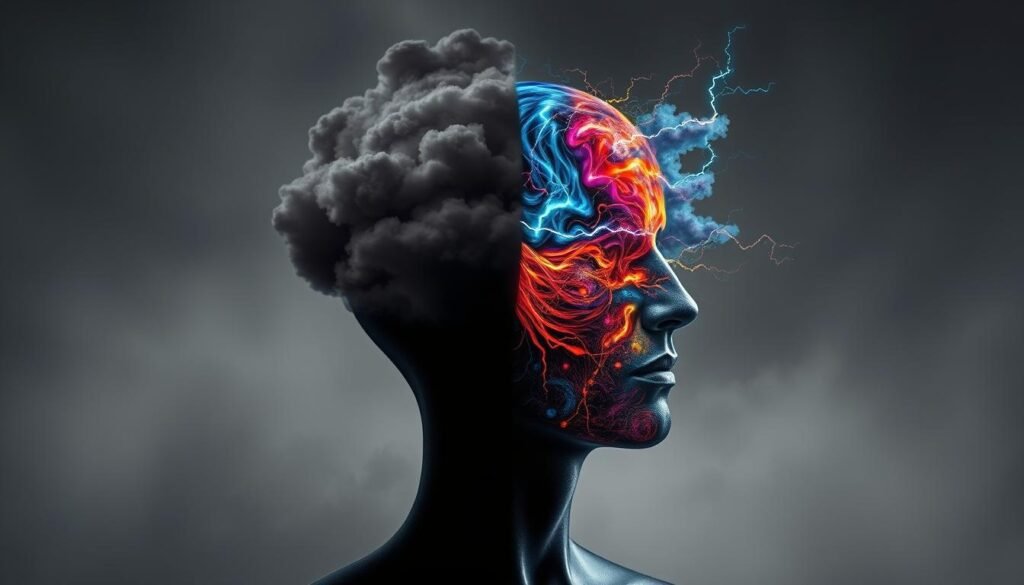Nearly 80% of people with migraines will also face depression. This high number shows an urgent need to understand the link between depression and migraines better. As mental health and headaches get more attention in healthcare, it’s key to know how these two serious issues often come together. By doing so, we can better treat them and improve patients’ lives.
It’s worrisome to see that those with chronic migraines could have more anxiety and even think about suicide. Considering that depression hits about 20% more women than men, and there is a genetic link between migraine and major depressive disorder, the connection is clearly complex. We will look into what factors play a role in this relationship. We will also explore if depression can cause migraines and how each condition affects the other over time.
Key Takeaways
- Nearly 80% of migraine sufferers experience depression at some point.
- Chronic migraine is associated with a higher risk of anxiety and suicidal tendencies.
- Depression prevalence is about 20% higher in females compared to males.
- Patients suffering from depression are at a two-fold higher risk for migraines.
- Genetic factors significantly influence both migraine and major depressive disorder.
- Effective treatment may include a combination of medications and lifestyle changes.
Introduction to Depression and Migraines
Depression and migraines are common but serious health issues that greatly affect a person’s feelings and daily life. Major depressive disorder (MDD) involves long-term sadness. It also includes a real lack of interest in anything.
People with MDD might feel unmotivated and have trouble sleeping. This can mess up their day-to-day life.
Migraines are different. They cause extreme headaches, nausea, and light sensitivity. These headaches can last a long time and are very intense. About 15% of people worldwide suffer from migraines. They are more common in women, especially those aged 35 to 39.
There’s a link between migraines and mood problems like anxiety and depression. If you get migraines, you might also feel very anxious or depressed. Studies show a strong connection between these conditions.
In fact, 20% of people with migraines might also be depressed. And 80% might feel depressed at some point. It’s key to understand how these illnesses affect each other.
The costs of migraines and depression are very high. In the U.S., depression costs hit $210 billion by 2010. Migraines can make it hard for people to work and enjoy life.
It’s important to know how mood disorders and migraines are linked. Adding mental health checks to migraine care could help. It might improve life for those dealing with these issues.
The Prevalence of Depression among Migraine Sufferers
Studies show a high rate of depression among those with migraines. About 5.4% of people surveyed reported migraines last year. Of those with migraines, 11.6% had both anxiety and depression. This shows migraines, depression, and anxiety often occur together. In contrast, 19.0% had only anxiety, and 6.1% had just depression. Meanwhile, 63.3% had neither.
It’s crucial to check for both depression and migraines. Around one third of those with migraines and anxiety also have depression. On the flip side, two-thirds with depression also experience anxiety. People with both conditions tend to have more severe headaches. This is linked to the number of migraines they get each month.
Between 25.5% to 57.6% of migraine patients may have anxiety. This shows the need for doctors to see the link between chronic pain and depression. They must create effective treatments for those suffering. The impact of these conditions makes dealing with migraines even harder.
Doctors should use tools like the Patient Health Questionnaire to understand this relationship better. The data stresses the need for prompt help for those battling both issues. For more details, click here.
can depression cause migraines
The link between migraines and depression is complex. Each condition can make the other worse. People with depression are more likely to get migraines. And those with migraines can feel more depressed.
The Bidirectional Relationship
Depression makes it 3.4 times more likely to get migraines. Migraine sufferers have a 5.8 times higher risk of getting depressed. This shows how both conditions often happen together, creating bigger challenges.
Factors Influencing the Connection
Many factors affect the link between mental health and headaches. Genetics is important, with certain genes linked to both conditions. Also, stress, lifestyle, and emotional issues can make both worse. The pain of migraines can disrupt sleep and cause stress, making depression deeper.
Keeping a clean and positive space can improve mental health. Making good changes at home can help ease migraine and depression symptoms.

Understanding the link between depression and migraines is key. Treating both the mind and body is crucial. A blend of medication, therapy, and lifestyle changes can lead to better health.
Understanding the Symptoms of Migraine and Depression
It’s crucial to know the main symptoms of migraine and depression for those affected. Migraine often causes severe, throbbing pain, nausea, and sensitivity to light and sound. These symptoms can greatly disrupt everyday life for people with chronic headaches.
Depression, on the other hand, shows up as hopelessness, fatigue, and a lack of interest in things once enjoyed. These symptoms overlap, making it hard to diagnose correctly. For example, in the U.S., around 40 million people suffer from migraines. Many of these people might also feel depressed and anxious.
Keeping track of migraine symptoms helps in managing the condition. Note how often, how long, and what triggers your migraines. A thorough check-up is crucial for patients with either condition. Treatments might include drugs, cognitive behavioral therapy (CBT), and biofeedback. These approaches aim to reduce pain and boost emotional wellness.

| Symptom | Migraine | Depression |
|---|---|---|
| Pain Type | Intense, throbbing | Persistent sadness |
| Nausea | Common | Uncommon |
| Light Sensitivity | Common | Possible discomfort |
| Fatigue | Post-migraine | Chronic |
| Loss of Interest | Not applicable | Prominent |
Recognizing symptoms is key in dealing with depression and migraine. Their connection means treatment should focus on both physical and emotional well-being. Knowing more about these conditions helps in seeking early treatment, thus improving life quality.
The Role of Stress and Other Triggers
It’s key to see how stress links to migraine triggers in managing these issues. Stress makes migraine symptoms worse and affects mental health. Knowing your triggers helps create management plans for those with migraines and anxiety.
Identifying Common Triggers
Many stress and migraine triggers exist. Knowing what they are can help sufferers act earlier. Common triggers are:
- Lack of sleep: Not getting enough sleep makes you more prone to migraines.
- Environmental changes: Things like changing weather can start an attack.
- Hormonal fluctuations: In women, hormone level changes can lead to migraines.
- Dietary choices: Some foods and drinks might set off symptoms in certain people.
About 4 out of 5 people see stress as a trigger for migraines. Indeed, 80% of those with migraines cite stress as a reason for their episodes. Knowing this helps in treating both anxiety and migraine more completely.
Stressful life situations are also a risk for starting chronic migraine. Those dealing with stress often have more headaches and symptoms of anxiety and migraine. Approaches that reduce stress, like therapy or relaxation techniques, can bring major relief. To learn more, check out studies on stress and migraine triggers.
Handling stress well can improve how you manage migraines and your overall mental health. Finding and knowing your own triggers can greatly enhance your life’s quality.

Exploring the Pathophysiology of Depression and Migraines
The link between chronic pain and depression is getting more focus lately. This is especially true for how they connect with migraines. Studies show that imbalances in neurotransmitters, like serotonin, play a big part in both migraines and depression. This highlights the common biological roots of these conditions.
Both genetics and the environment affect the start of migraines and depression. Studies show that people with migraines may more likely get depressed. About 20% of the differences in migraines and depression come from shared genes.
A table below shows the main factors. It points out how chronic pain and depression share traits with migraines.
| Factor | Chronic Pain and Depression | Pathophysiology of Migraine |
|---|---|---|
| Common Neurotransmitter | Imbalance of serotonin | Defective serotonergic dysfunction |
| Genetic Contribution | Shared genetic factors (20% variability) | Heritability of 30-50% between migraine and MDD |
| Impact on Brain Structure | Lower overall brain volume | Accelerated aging effects in brain size |
| Risk Factors | Obesity, stress, and hormonal influences | Hormonal fluctuations with estrogen and progesterone |
| Treatment Approaches | Integrated targeting of both conditions | Tricyclic antidepressants like amitriptyline are effective |
Researching migraines and their link to chronic pain and depression is important. It helps us understand how these issues impact each other. Plus, it shows the need for treatments that address all aspects.
Mental Health and Headaches: A Complex Link
The link between mental health and headaches is complex. It highlights how mood disorders and migraine can affect a person’s life. Research shows mood disorders can make migraine episodes more frequent and intense. Understanding this connection helps create better treatment plans for both psychological and physical symptoms.
The Impact of Mood Disorders on Migraine Frequency
People with mental health issues often face physical symptoms like fatigue and sleeplessness. Headaches, especially tension-type and migraines, are common in those with depression and anxiety. Treating mental health issues might also reduce headache symptoms.
Migraine sufferers with PTSD face more headaches and daily challenges. They deal with more disability than those without PTSD. Understanding mood disorder triggers can guide early treatment and improve individual care.
About 29% of people with migraines feel depressed, unlike 12% of those without. This shows the need to consider mental health in headache treatment. Women with migraine with aura are at an even higher risk for depression, with odds twice as high.
Addressing the role of mood disorders in migraine can lead to lifestyle changes. Stress management and better sleep can improve people’s lives. These efforts, alongside medical treatment, raise the chance of better outcomes for those with both conditions.
| Condition | Prevalence of Depression (% of population) | Prevalence Among Migraine Sufferers (%) |
|---|---|---|
| Women | 12.6 | 29 |
| Men | 6.3 | 12 |
| Migraine with Aura | Varies | Higher odds for depression (OR 2.24 for women) |
| Chronic Daily Headaches | Higher odds | Greater prevalence of major depression |
Chronic Pain and Depression: A Coexisting Challenge
Many people face challenges with chronic pain and depression, especially with chronic migraines. Nearly 20% of folks in the USA and Europe deal with chronic pain. This issue is a big concern for public health. Interestingly, about 85% of those with chronic pain also experience severe depression. This shows a strong link between chronic pain and depression. This is really worrying for migraine sufferers, as about 40% of them also have depression.
Chronic migraines can make depression worse, starting a cycle of pain and mental distress. This results in less productivity and a lower quality of life. People often feel more anxious too. This situation shows why it’s important for doctors to be aware and to have treatment plans that tackle both issues at the same time. A symptom-based treatment can help understand how chronic pain and depression interact. It can reveal how anxiety and depression play a role in migraine risk.
Getting the right treatment can greatly help people’s well-being. Treatments like cognitive-behavioral therapy and medicines such as amitriptyline and venlafaxine are effective. It’s key to find treatments that help with migraines and also the depression that can come with it. If you want to understand more about this topic, reading studies like the one in this research article can be very insightful.